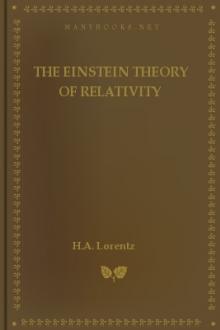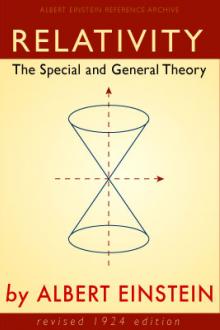The Einstein Theory of Relativity by H. A. Lorentz (bill gates best books txt) 📕

- Author: H. A. Lorentz
- Performer: -
Book online «The Einstein Theory of Relativity by H. A. Lorentz (bill gates best books txt) 📕». Author H. A. Lorentz
So far as the absolute extent of the displacements is concerned, it was found somewhat too great, as has been shown by the figures given page 57above; it also appears from the final result to be 1.98 for the edge of the sun—i.e., 13 per cent, greater than the theoretical value of 1.75. It indeed seems that the discrepancies may be ascribed to faults in observations, which supposition is supported by the fact that the observations at Prince's Island, which, it is true, did not turn out quite as well as those mentioned above, gave the result, of 1.64, somewhat lower than Einstein's figure.
(The observations made with a second instrument at Sobral gave a result of 0.93, but the observers are of the opinion that because of the shifting of the mirror which reflected the rays no value is to be attached to it.) page 58
Difficulty ExaggeratedDuring a discussion of the results obtained at a joint meeting of the Royal Society and the Royal Astronomical Society held especially for that purpose recently in London, it was the general opinion that Einstein's prediction might be regarded as justified, and warm tributes to his genius were made on all sides. Nevertheless, I cannot refrain, while I am mentioning it, from expressing my surprise that, according to the report in The Times there should be so much complaint about the difficulty of understanding the new theory. It is evident that Einstein's little book page 59“About the Special and the General Theory of Relativity in Plain Terms,” did not find its way into England during wartime. Any one reading it will, in my opinion, come to the conclusion that the basic ideas of the theory are really clear and simple; it is only to be regretted that it was impossible to avoid clothing them in pretty involved mathematical terms, but we must not worry about that.
I allow myself to add that, as we follow Einstein, we may retain much of what has been formerly gained. The Newtonian theory remains in its full value as the first great step, without which one cannot imagine the development of astronomy and without which the second step, that has now been made, page 60would hardly have been possible. It remains, moreover, as the first, and in most cases, sufficient, approximation. It is true that, according to Einstein's theory, because it leaves us entirely free as to the way in which we wish to represent the phenomena, we can imagine an idea of the solar system in which the planets follow paths of peculiar form and the rays of light shine along sharply bent lines—think of a twisted and distorted planetarium—but in every case where we apply it to concrete questions we shall so arrange it that the planets describe almost exact ellipses and the rays of light almost straight lines.
It is not necessary to give up entirely even the ether. Many natural philosophers find satisfaction in the page 61idea of a material intermediate substance in which the vibrations of light take place, and they will very probably be all the more inclined to imagine such a medium when they learn that, according to the Einstein theory, gravitation itself does not spread instantaneously, but with a velocity that at the first estimate may be compared with that of light. Especially in former years were such interpretations current and repeated attempts were made by speculations about the nature of the ether and about the mutations and movements that might take place in it to arrive at a clear presentation of electro-magnetic phenomena, and also of the functioning of gravitation. In my opinion it is not impossible that in the future page 62this road, indeed abandoned at present, will once more be followed with good results, if only because it can lead to the thinking out of new experimental tests. Einstein's theory need not keep us from so doing; only the ideas about the ether must accord with it.
Nevertheless, even without the color and clearness that the ether theories and the other models may be able to give, and even, we can feel it this way, just because of the soberness induced by their absence, Einstein's work, we may now positively expect, will remain a monument of science; his theory entirely fulfills the first and principal demand that we may make, that of deducing the course of phenomena from certain principles exactly and page 63to the smallest details. It was certainly fortunate that he himself put the ether in the background; if he had not done so, he probably would never have come upon the idea that has been the foundation of all his examinations.
Thanks to his indefatigable exertions and perseverance, for he had great difficulties to overcome in his attempts, Einstein has attained the results, which I have tried to sketch, while still young; he is now 45 years old. He completed his first investigations in Switzerland, where he first was engaged in the Patent Bureau at Berne and later as a professor at the Polytechnic in Zurich. After having been a professor for a short time at the University of Prague, he settled in Berlin, where page 64the Kaiser Wilhelm Institute afforded him the opportunity to devote himself exclusively to his scientific work. He repeatedly visited our country and made his Netherland colleagues, among whom he counts many good friends, partners in his studies and his results. He attended the last meeting of the department of natural philosophy of the Royal Academy of Sciences, and the members then had the privilege of hearing him explain, in his own fascinating, clear and simple way, his interpretations of the fundamental questions to which his theory gives rise.
End of the Project Gutenberg EBook of The Einstein Theory of Relativity, by H.A. Lorentz.
This file should be named 11335-h.html or 11335-h.zip.
This and all associated files of various formats will be found in:
http://www.gutenberg.net/1/1/3/3/11335/
Produced by Jeroen Hellingman.
Updated editions will replace the previous one—the old editions will be renamed.
Creating the works from public domain print editions means that no one owns a United States copyright in these works, so the Foundation (and you!) can copy and distribute it in the United States without permission and without paying copyright royalties. Special rules, set forth in the General Terms of Use part of this license, apply to copying and distributing Project Gutenberg™ electronic works to protect the PROJECT GUTENBERG™ concept and trademark. Project Gutenberg is a registered trademark, and may not be used if you charge for the eBooks, unless you receive specific permission. If you do not charge anything for copies of this eBook, complying with the rules is very easy. You may use this eBook for nearly any purpose such as creation of derivative works, reports, performances and research. They may be modified and printed and given away—you may do practically ANYTHING with public domain eBooks. Redistribution is subject to the trademark license, especially commercial redistribution.
THE FULL PROJECT GUTENBERG LICENSEPLEASE READ THIS BEFORE YOU DISTRIBUTE OR USE THIS WORK
To protect the Project Gutenberg™ mission of promoting the free distribution of electronic works, by using or distributing this work (or any other work associated in any way with the phrase "Project Gutenberg"), you agree to comply with all the terms of the Full Project Gutenberg™ License (available with this file or online at http://gutenberg.net/license).
Section 1. General Terms of Use and Redistributing Project Gutenberg™ Electronic Works1.A. By reading or using any part of this Project Gutenberg™ electronic work, you indicate that you have read, understand, agree to and accept all the terms of this license and intellectual property (trademark/copyright) agreement. If you do not agree to abide by all the terms of this agreement, you must cease using and return or destroy all copies of Project Gutenberg™ electronic works in your possession. If you paid a fee for obtaining a copy of or access to a Project Gutenberg™ electronic work and you do not agree to be bound by the terms of this agreement, you may obtain a refund from the person or entity to whom you paid the fee as set forth in paragraph 1.E.8.
1.B. "Project Gutenberg" is a registered trademark. It may only be used on or associated in any way with an electronic work by people who agree to be bound by the terms of this agreement. There are a few things that you can do with most Project Gutenberg™ electronic works even without complying with the full terms of this agreement. See paragraph 1.C below. There are a lot of things you can do with Project Gutenberg™ electronic works if you follow the terms of this agreement and help preserve free future access to Project Gutenberg™ electronic works. See paragraph 1.E below.
1.C. The Project Gutenberg Literary Archive Foundation ("the Foundation" or PGLAF), owns a compilation copyright in the collection of Project Gutenberg™ electronic works. Nearly all the individual works in the collection are in the public domain in the United States. If an individual work is in the public domain in the United States and you are located in the United States, we do not claim a right to prevent you from copying, distributing, performing, displaying or creating derivative works based on the work as long as all references to Project Gutenberg are removed. Of course, we hope that you will support the Project Gutenberg™ mission of promoting free access to electronic works by freely sharing Project Gutenberg™ works in compliance with the terms of this agreement for keeping the Project Gutenberg™ name associated with the work. You can easily comply with the terms of this agreement by keeping this work in the same format with its attached full Project Gutenberg™ License when you share it without charge with others.
1.D. The copyright laws of the place where you are located also govern what you can do with this work. Copyright laws in most countries are in a constant state of change. If you are outside the United States, check the laws of your country in addition to the terms of this agreement before downloading, copying, displaying, performing, distributing or creating derivative works based on this work or any other Project Gutenberg™ work. The Foundation makes no representations concerning the copyright status of any work in any country outside the United States.
1.E. Unless you have removed all references to Project Gutenberg:
1.E.1. The following sentence, with active links to, or other immediate access to, the full Project Gutenberg™ License must appear prominently whenever any copy of a Project Gutenberg™ work (any work on which the phrase "Project Gutenberg" appears, or with which the phrase "Project Gutenberg" is associated) is accessed, displayed, performed, viewed, copied or distributed:
This eBook is for the use of anyone anywhere at no cost and with almost no restrictions whatsoever. You may copy it, give it away or re-use it under the terms of the Project Gutenberg License included with this eBook or online at www.gutenberg.net.
1.E.2. If an individual Project Gutenberg™ electronic work is derived from the public domain (does not contain a notice indicating that it is posted with permission of the copyright holder), the work can be copied and distributed to anyone in the United States without paying any fees or charges. If you are redistributing or providing access to a work





Comments (0)